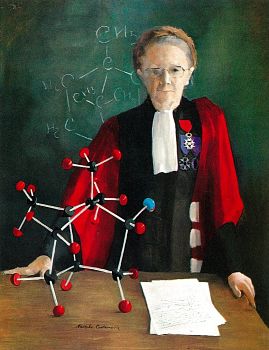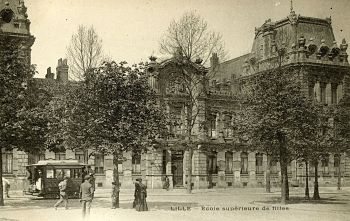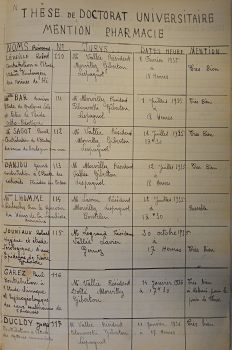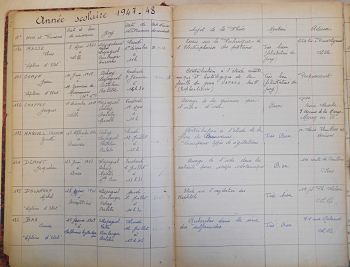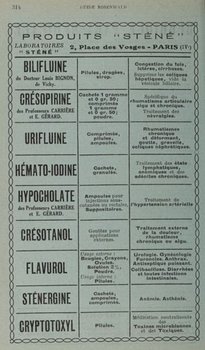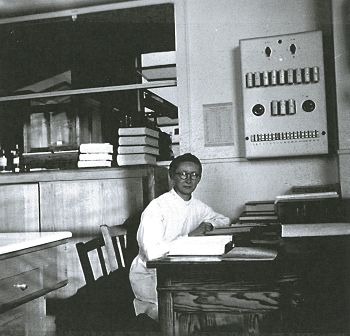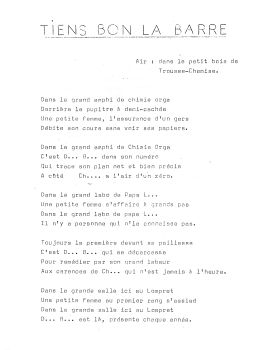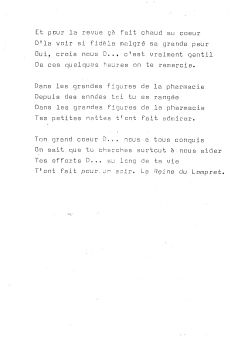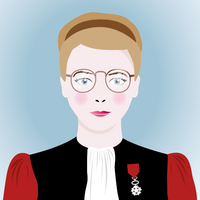
The first female professor[1] of Pharmacy at the University of Lille, Denise Bar obtained a baccalauréat in elementary mathematics before continuing her studies at the Faculty of Science and then at the Combined Faculty of Medicine and Pharmacy. In 1935, she obtained a doctorate in ortho-cresotic acid. While continuing her research, she worked in a pharmaceutical laboratory. Although she began teaching in 1939, she didn’t really start her academic career until 1942, when she began working as an ‘assistante’ (junior member of the faculty’s teaching staff). A winner of the pharmacists’ competitive examinations, she defended her doctoral thesis on sulfonamides in 1948. After being ranked first in the agrégation competitive teaching exam in 1949 and becoming a ‘professeure agrégée’ (associate professor), she became a professor without a chair in 1955. Her research focused in particular on pharmaceutical chemistry. Recognised by her peers, she received the Kuhlmann Prize from the Lille Society of Science, Agriculture and Art in 1965. In 1977, she was appointed Professor Emeritus, and two years later, she was made a Chevalier in the Order of the Legion of Honour in 1979.
Childhood, family environment and secondary education
Denise Bar was born in Hallennes-lez-Haubourdin (Nord, France) on 25 January 1909 to a father who was a sales clerk and later co-owner of a clothing workshop, and a mother who was a schoolteacher.
She began her education during the First World War, in 1916. As a result, classes were held in cafés – the school having been requisitioned by the Germans. After attending supplementary classes at the Jules Ferry school in Haubourdin, she joined the Jean Macé school in Lille in 1925. At this school you could only study towards the brevet supérieur, not the baccalauréat. This diploma was essential for admission to university. As a result, Denise Bar continued her studies at the Lycée de Fénelon in Lille, graduating with a baccalauréat in elementary mathematics in 1928.
At the time, it was common for girls to be directed to a school that did not allow them to study towards the baccalauréat, but only the brevet supérieur. For example, many of the female students who enrolled in pharmacy at the same time as Denise Bar were also two years behind the boys or were the few girls who had been directed earlier towards specialising in mathematics in their final years of secondary education.
Graduate studies and doctoral theses
Armed with her precious baccalauréat, Denise Bar simultaneously studied pharmacy and science in Lille. She passed all her exams with flying colours, obtained her Bachelor of Science and was laureate of the faculty in 1930 and again in 1932.
She defended a doctoral thesis in the field of pharmacy (3rd cycle thesis) entitled Study of Some Ortho-cresotic Acid Salts and Esters on 1 July 1935, graduating with honours; her thesis jury was chaired by Professor Frédéric Morvillez and also included Professors Michel Polonovski, André Giberton and Albert Lespagnol.
Research into the Sulfonamide Series on 12 July 1948 and was once again awarded the distinction ‘very good’; her thesis jury was made up of professors Albert Lespagnol, Cyrille Vallée, Paul Boulanger and Paul Balatre.
Pharmaceutical jobs and an academic career
After completing her first thesis, from 1935 to 1939 Denise Bar worked at Laboratoires Sténé, directed by Professor Lemoine and headquartered at 2 place des Vosges, Paris. As a result of the Second World War, Laboratoires Sténé, like other Lille laboratories such as Amido and Liposeptine, left Lille – situated in the occupied zone at that time – and retreated to Allier, which was in the free zone. Laboratoires Sténé moved to Moulins in October 1939, and Denise Bar temporarily stopped working there.
With the men away at the front, she replaced Professor Albert Lespagnol at the Liposeptin Laboratory from September 1939, where she was in charge of analyses and the manufacture of pharmaceutical specialities. She began teaching at the Faculty in 1939, but the war and the risk of bombing interrupted her second year of teaching.
In June 1940, the Lille faculty briefly retreated to Le Touquet and then to Rennes. Denise Bar followed the evacuation, but returned to Lille in September 1940 to continue her activities throughout the war.
After the war, she went back to work at the Laboratoire de la Liposeptine – located on rue du magasin in Lille and famous for its Marrubène specialities (elixir and granules). At the same time, Denise Bar became ‘chef de travaux’ (senior researcher) in organic chemistry at the Lille Combined Faculty of Medicine and Pharmacy.
With the men away at the front, she replaced Professor Albert Lespagnol at the Liposeptin Laboratory from September 1939, where she was in charge of analyses and the manufacture of pharmaceutical specialities. She began teaching at the Faculty in 1939, but the war and the risk of bombing interrupted her second year of teaching.
In June 1940, the Lille faculty briefly retreated to Le Touquet and then to Rennes. Denise Bar followed the evacuation, but returned to Lille in September 1940 to continue her activities throughout the war.
After the war, she went back to work at the Laboratoire de la Liposeptine – located on rue du magasin in Lille and famous for its Marrubène specialities (elixir and granules).
At the same time, Denise Bar became ‘chef de travaux’ (senior researcher) in organic chemistry at the Lille Combined Faculty of Medicine and Pharmacy.
Denise Bar went on to hold various positions and ranks of increasing importance in the university hierarchy:
- temporary ‘assistante’ (junior member of the faculty’s teaching staff) (1942-1943);
- deputy ‘chef de travaux’ (senior researcher) in practical chemistry (1943-1944);
- ‘chef de laboratoire’ (laboratory manager) (1944-1945);
- tenured ‘assistante’ (1945);
- tenured ‘chef de travaux’ (senior researcher) (1946);
- ‘chef de travaux’ (senior researcher) in organic chemistry (1947-1948);
- trainee ‘professeur agrégé’ (associate professor)[2] (maître de conférences[3]) (1949-1952);
- tenured ‘maître de conférences’ (senior lecturer) (1952-1955);
- professor without a chair (1955-1956);
- professor of organic chemistry (1957-1978);
- professor Emeritus (1978-1981).
Denise Bar also successfully sat the ‘Hospital Pharmacist’ competitive examination, which until then had been closed to women. She then worked at the psychiatric hospital in Armentières and briefly owned her own pharmacy in Arras (30 rue Gambetta) between 27 December 1941 and 5 January 1943. At the same time, she was a temporary volunteer assistant at the faculty.
Denise Bar also held a number of positions, including Vice-President of the Regional Council of the Order of Pharmacists (Conseil régional de l’Ordre des pharmaciens; CROP) for the Nord - Pas-de-Calais region.
Honours and awards
- Thesis prize from the OCP (Office Commercial Pharmaceutique) – a French wholesaler distributor – for her thesis on ortho-cresotic acid (1935);
- Grand Prix des Sciences pharmaceutiques (1950), then Grand Prix Kuhlmann (1965), both awarded by the Société des Sciences, de l’Agriculture et des Arts de Lille (SSAAL);
- Insignia of ‘Chevalier’ in the Order of the Legion of Honour, on behalf of the Ministry of Universities, awarded on 28 January 1979 by Professor Albert Lespagnol, ‘Officier’ of the Legion of Honour, member of the National Academy of Medicine and member of the Academy of Pharmacy.
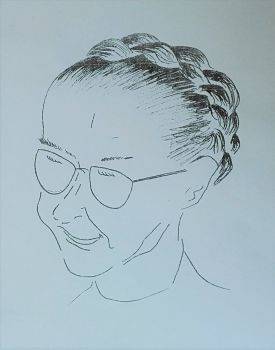
Main scientific publications
In addition to her two theses mentioned above, Denise Bar published or co-published, notably with Professor Albert Lespagnol(3,6), educational books on organic chemistry and therapeutic chemistry as well as scientific articles, and given lectures(5) in fields relating to pharmaceutical sciences and pharmacy as a profession(1,8). A Professor of Organic Chemistry in Pharmacy, she published her research into the synthesis of original molecules with potential pharmacological properties(2,4,7,9).
Notes written by Hélène Lehmann, MCU in Pharmaceutical Health Law, Faculty of Pharmacy, University of Lille, and Annie Marcincal, Honorary Professor in Organic Chemistry, Faculty of Pharmacy, University of Lille.
Notes
[1] If this biography uses feminine terms to refer to Denise Bar’s titles and functions, we feel it’s important to point out that it would never have occurred to her to do so.
[2] As the Agrégation competitive examination was suspended during the 1939-1945 war, Denise Bar sat it after the war, in 1949. This competition examination was essentially closed to women until the year Denise Bar entered it and came first.
[3] The title of ‘maître de conférences’ at the time corresponded to ‘professeur agrégé’, just as the title of ‘chef de travaux’ led to the former status of ‘maître-assistant’, then to the current status of ‘maître de conférences’.
[4] When we look at the students’ masterpieces, the ‘Revue de Pharma’ songs in which each teacher in turn got to enjoy an ‘augmented reality’ description of his or her shortcomings, which were no doubt unfair or exaggerated, and reread the songs dedicated to ‘la Miss’, we find evidence of the students’ affection for Denise Bar.
She spared no effort to help those in difficulty, and her students knew they could count on her.
What’s more, her lectures were clear and well constructed, and students appreciated the ease with which they were able to take notes in an age when the course was not available on the Internet.
Yet Denise Bar always made an austere, but not to say stern, first impression, which concealed a witty and even subtly joking, sometimes gently mocking, nature that she showed in the many speeches she was asked to deliver. Her speeches were brilliant and revealed her tremendous learning..
Bibliography
Denise Bar biography resources
Combined Faculty of Medicine and Pharmacy Collection. Nord Department Archives.
Gérard Biserte, Histoire de la faculté mixte de médecine et de pharmacie de Lille,Lille 1979, vol. I, p. 139 and vol. II, p. 489.
Denise Bar / 28 January 1979,leaflet published following the award of the insignia of ‘Chevalier dans l’ordre de la Légion d'Honneur’ to Denise Bar, 1979
SSAAL website: societe-sciences-agriculture-arts-lille.fr/wp-content/uploads/2017/02/Microsoft-Word-PrixSSAAL1944-1969.pdf
Denise Bar’s publications (referenced in the text)
1 – Contrôle des médicaments chimiques à l’Officine,s. l. n.d.
2 – A. Lespagnol, C. Levaditi and D. Bar, Recherches dans le série des sulfamides,s. l. n. d.
3 – A. Lespagnol and D. Bar, Cours de Chimie organique à l’usage des étudiants en Pharmacie,1948, Collection Les cours de Sorbonne, ISSN 0574-3508.
4 – J. Piquet, D. Bar et H. Boisse, ‘Étude comparative d’un nouveau dérivé sulfamidé’, L’Echo Médical du Nord,November 1953, Imprimerie Centrale du Nord, 12, rue Lepelletier, Lille, 1953.
5 – D. Bar, ‘Les Médicaments de l’hypertension’, Bulletin de la Société de Pharmacie de Lille,1956, no. 2, pp. 53-70, Imprimerie A. Gatti, 128, rue du Faubourg de Roubaix, Lille.
6 – A. Lespagnol, C. Lespagnol, D. Bar et M. Dautrevaux, Quelques aspects de la chimie des médicaments,Masson, 1966.
7 – C. Lespagnol, D. Bar, A. Marcincal-Lefebvre, P. Marcincal, L. Masse, ‘Benzolkernalkylierung von benzoxazolinon’, Chemischer Informationsdienst / Organische Chemie,no. 2 (22), 1971.
8 – D. Bar, ‘Grandeur et servitude du métier de pharmacien’, Bulletin de l’Ordre des Pharmaciens,no. 195, December 1976. This text corresponds to the speech given by Denise Bar when she swore in the class of 1976 at the Lille Faculty of Pharmacy on 24 June 1976.
9– D. Bar, A. Marcincal-Lefebvre et J.-C. Gesquiere, ‘Synthèse de phénylthio-4 phénylhydrazines et de quelques dérivés’, Annales Pharmaceutiques Françaises,1980, 38, no. 2, pp. 161-168, Masson, Paris 1980.
- Ms Nicole Trupin, Denise Bar’s niece, for the information she provided on Denise Bar’s childhood and youth;
- Ms Nathalie Barré-Lemaire, archivist at the University of Lille, for her invaluable help in researching archive documents relating to Denise Bar’s thesis defence and academic career.

